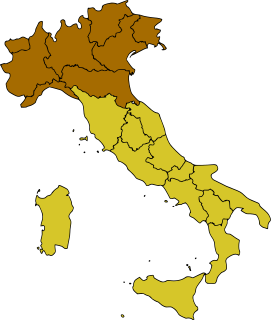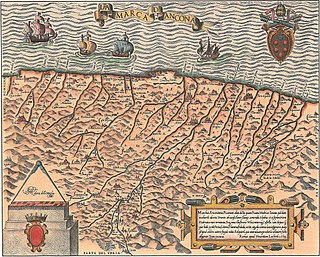See also
| This disambiguation page lists articles associated with the title Marca. If an internal link led you here, you may wish to change the link to point directly to the intended article. |
Marca may refer to:
Places:
Regions (marches):
People:
Nature
In other fields:
| This disambiguation page lists articles associated with the title Marca. If an internal link led you here, you may wish to change the link to point directly to the intended article. |

Ancona is a city and a seaport in the Marche region in central Italy, with a population of around 101,997 as of 2015. Ancona is the capital of the province of Ancona and of the region. The city is located 280 km (170 mi) northeast of Rome, on the Adriatic Sea, between the slopes of the two extremities of the promontory of Monte Conero, Monte Astagno and Monte Guasco.

Liguria is a coastal region of north-western Italy; its capital is Genoa. The region almost coincides with the Italian Riviera and is popular with tourists for its beaches, towns, and cuisine.

Sălaj County is a county (județ) of Romania, located in the north-west of the country, in the historical regions of Crișana and Transylvania. It is bordered to the north by Satu Mare and Maramureș counties, to the west and south-west by Bihor County, and to the south-east by Cluj County. Zalău is the county seat as well as its largest city.

Marche or the Marches is one of the twenty regions of Italy. The name of the region derives from the plural name of marca, originally referring to the medieval March of Ancona and nearby marches of Camerino and Fermo. Marche is well known for its shoemaking tradition, with the finest and most luxurious Italian footwear being manufactured in this region.
In medieval Europe, a march or mark was, in broad terms, any kind of borderland, as opposed to a notional "heartland". More specifically, a march was a border between realms, and/or a neutral/buffer zone under joint control of two states, in which different laws might apply. In both of these senses, marches served a political purpose, such as providing warning of military incursions, or regulating cross-border trade, or both.

Zalău is the seat of Sălaj County, Romania. In 2011, its estimated population was 56,202.

Bologna Centrale is a railway station in Bologna, Italy. The station is situated at the northern edge of the city centre. It is located at the southern end of the Milan-Bologna high-speed line, which opened on 13 December 2008, and the northern end of three lines between Bologna and Florence: the original Bologna-Florence line through Porretta Terme and Pistoia; the Bologna–Florence Direttissima via Prato, which opened on 22 April 1934 and the Bologna-Florence high-speed line, which opened to traffic on 13 December 2009.

The Julian March or Julian Venetia is an area of southeastern Europe which is currently divided among Croatia, Italy and Slovenia. The term was coined in 1863 by the Italian linguist Graziadio Isaia Ascoli, a native of the area, to demonstrate that the Austrian Littoral, Veneto, Friuli and Trentino shared a common Italian linguistic identity. Ascoli emphasized the Augustan partition of Roman Italy at the beginning of the Empire, when Venetia et Histria was Regio X.

Northern Italy is a geographical and cultural region in the northern part of Italy. Non-administrative, it consists of eight administrative Regions in northern Italy: Aosta Valley, Piedmont, Liguria, Lombardy, Emilia-Romagna, Veneto, Friuli-Venezia Giulia and Trentino-Alto Adige/Südtirol. As of 2014, its population was 27,801,460. Rhaeto-Romance and Gallo-Italic languages are spoken in the region, as opposed to the Italo-Dalmatian languages spoken in the rest of Italy.

Romania's administration is relatively centralized and administrative subdivisions are therefore fairly simplified.

Nord-Vest is a development region in Romania, created in 1998. As other development regions, it does not have any administrative powers, its main function being to co-ordinate regional development projects and manage funds from the European Union.
Oberto I Obizzo was an Italian count palatine and margrave and the oldest known member of the Obertenghi family.

The March of Ancona was a frontier march centred on the city of Ancona and, then, Macerata in the Middle Ages. Its name is preserved as an Italian region today, the Marches, and it corresponds to almost the entire modern region and not just the Province of Ancona.
The Obertenghi were a prominent Frankish noble family of Italian nobility descended from Viscount Adalbert III, first Margrave of Milan. The dynasty is the progenitor of the widely powerful and prestigious House of Este, as well the House of Welf, parent house of the Hanover dynasty. Other cadet lines includes the Malaspina and Pallavicini families.
The March or Marquisate of Turin was a territory of medieval Italy from the mid-10th century, when it was established as the Arduinic March. It comprised several counties in Piedmont, including the counties of Turin, Auriate, Albenga and, probably, Ventimiglia. The confines of the march thus stretched across the Po Valley from the Western Alps in the north, to the Ligurian Sea.

The Marchof Montferrat was a frontier march of the Kingdom of Italy during the Middle Ages and a state of the Holy Roman Empire. The margraviate was raised to become the Duchy of Montferrat in 1574.
The March of Genoa or Eastern Liguria was created in 961 by the Emperor Otto I. It was originally called either the marca Obertenga after its first holder, Oberto I, or the marca Januensis after its original capital and chief city, Genoa. Its creation was part of a general reorganisation of the northwest of Italy into three frontier districts. Western Liguria became the March of Montferrat and the interior became the March of Turin. It comprised the counties of Luni, Tortona, Milan, and Genoa.
Rus, or RUS may refer to:

The United States Consulate General in Milan presides over the interests of the United States in Northern Italy.
Cassa di Risparmio di Verona, Vicenza, Belluno e Ancona known as Cariverona in short, was an Italian savings bank headquartered in Verona. In 1991, due to Legge Amato, the bank was split into two organizations, Cassa di Risparmio di Verona, Vicenza, Belluno e Ancona S.p.A. and Fondazione Cassa di Risparmio di Verona, Vicenza, Belluno e Ancona. They joined Unicredito banking group as founding subsidiary and shareholder respectively. The banking foundation was a minority shareholder of the successor of the banking group UniCredit.